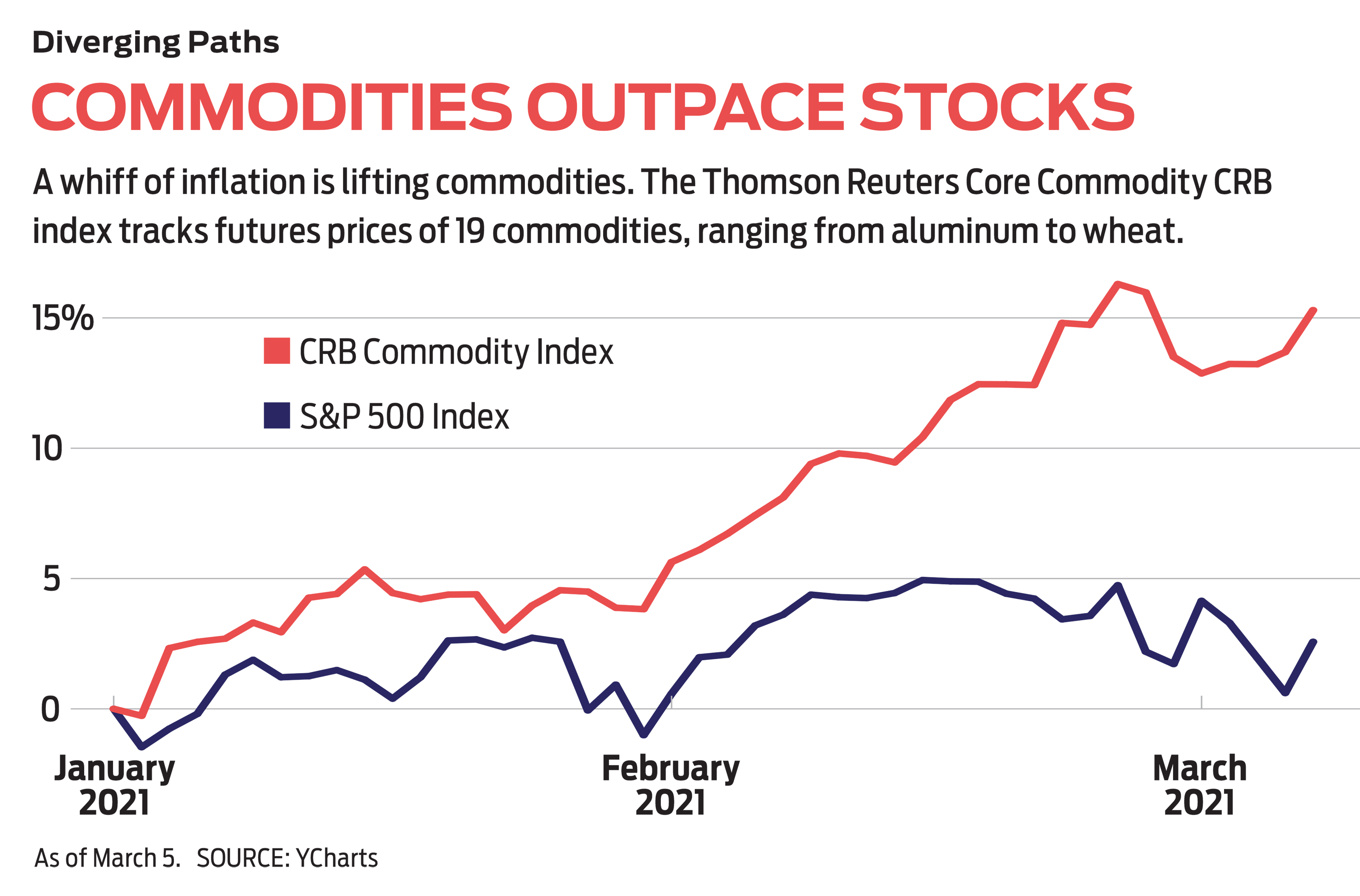Why You Should Consider Commodities
Besides offering protection against inflation, commodities are good diversifiers in a portfolio.


Inflation is still low, but it’s rising. You can see it reflected in interest rates. The yield on 10-year Treasury notes soared from 0.52% in early August to 1.6% in early March. Investors demand higher rates when they worry that rising prices will mean the dollar will have less purchasing power when their bonds mature.
You can also see inflation in the prices of commodities, or basic raw materials. The cost of food rose 3.6% over the 12 months that ended February 28, reports the U.S. Bureau of Labor Statistics, and the gasoline index jumped 6.4% in January alone. About two dozen commodities—from corn to crude oil to cattle to copper—actively trade on U.S. markets. For some, price increases have been dramatic. Soybeans rose nearly 50% over the past six months; lumber nearly doubled in four months. In a three-week period in February, the price of copper jumped over 20%. (Unless noted, prices and other data are as of March 5; recommendations are in bold.)
Besides offering protection against inflation, commodities are good diversifiers in a portfolio because they are only about 30% correlated with stocks. When one asset is down, the other is often up, and vice versa. But when the stock market tanked last February and March because of the COVID-19 pandemic, so did most commodities—and for the same reason: plunging demand from consumers who lost their jobs. Of course, everyone has to eat, so food prices held up. But other commodities plummeted, before returning slowly but consistently as the economy began to recover.

Sign up for Kiplinger’s Free E-Newsletters
Profit and prosper with the best of expert advice on investing, taxes, retirement, personal finance and more - straight to your e-mail.
Profit and prosper with the best of expert advice - straight to your e-mail.
A fork in the road. Stocks and commodities started to diverge significantly as 2021 began. That’s because businesses are allergic to rising interest rates, which increase their own and their customers’ borrowing costs, but the prices of staples are largely unaffected (unless rates get way out of hand and trigger an economic slowdown).
Despite recent price increases, however, commodities have been in a long-term bear market since the 2008–09 recession. A $10,000 investment 10 years ago in a popular exchange-traded security, iShares S&P GSCI Commodity-Indexed Trust (symbol GSG, $15), is now worth $3,878, according to Morningstar. By contrast, the same investment in SPY, the SPDR S&P 500 exchange-traded fund, would have grown to $35,657.
The problem for commodity prices has been sluggish economic growth in the U.S. and Europe, and a decline in the spectacular annual growth in China’s gross domestic product, down from double-digit percentages in the early 2000s to less than 7% today. Global inflation has dropped in major economies to below 2%, despite all the money that central banks keep injecting.
Is the decline in commodity prices long-lasting and the recent upward blip just temporary? Or, as analysts at Goldman Sachs recently predicted, is this “the beginning of a much longer-term structural bull market”? My definitive answer is that I do not know. Inflation is rising and the U.S. economy is getting a huge dose of stimulus. But a powerful low-growth/low-inflation trend is difficult to buck.
I do believe, however, that because accurate predictions about inflation are nearly impossible, all investors should have some exposure to commodities. That doesn’t mean buying them directly in the futures market, where you use enormous leverage to purchase, say, a contract for 5,000 bushels of wheat (recently valued at about $33,000) or 50,000 pounds of cotton (about $45,000).
In these transactions, an investor typically puts up only 3% to 12% of the price of a contract and borrows the rest. Unless you want your backyard filled with hogs or barley, you sell before the delivery date. Right now, you can control a wheat contract for about $1,700. If wheat prices rise by about 5%, as they did in the first two months of the year, you double your money. If prices fall by the same amount, as they did during the month of November, you’re wiped out.
Wise investing has nothing in common with that kind of high-stakes gambling. I had personal experience in commodities when I was in my twenties. It was exhilarating when my first contracts were wins, but then I lost my shirt. So stay away. Instead, try one of the following approaches.
How to invest. First, you can own exchange-traded securities that track broad portfolios of commodity contracts. The S&P portfolio cited earlier is not a standard ETF, but a trust that buys and sells indexed futures contracts, backed by collateral such as Treasury securities. It’s a good choice if you want a heavy energy weighting; crude oil represents 45% of assets.
I prefer the more balanced iPath Bloomberg Commodity Index Total Return ETN (DJP, $25), linked to an index whose target weights are: 30% energy, 23% grains, 19% precious metals, 16% industrial metals and the rest livestock and “softs” such as cotton and coffee. With an ETN, or exchange-traded note, you are actually lending money—in this case, to Barclays Bank—with no guarantee of repayment. The value of the note rises or falls according to the value of the underlying commodities.
Trusts and notes are slightly more risky than standard ETFs, but in these two cases the issuers are sound. The Bloomberg security’s 10-year annualized return is about two points better than the S&P fund’s, but both are negative. For index funds, both have steep expense ratios: 0.76% for the S&P fund and 0.70% for the Bloomberg fund.
The second strategy is to buy individual stocks. A good example is Archer Daniels Midland (ADM, $58), a large supplier and refiner of grains and vegetable oils, that carries a 2.6% dividend yield. Bunge (BG, $78), a smaller, 202-year-old St. Louis company in the same sector, also yields 2.6%. ADM has returned 54% in the past year, and Bunge, 65%, but both should be good values if inflation keeps increasing.
Investing in London-based Rio Tinto Group (RIO, $84), a mining and processing company with a $132 billion market value, is a way to play both precious and base metals—gold, silver, aluminum, molybdenum, copper, iron ore, uranium and more. The stock is yielding 5.6%. An even larger global minerals firm, BHP Group (BHP, $76) of Australia, has been on a tear but trades well below its 2011 high and yields 4.1%. BHP focuses on many of the same commodities as Rio Tinto, with the addition of coal and petroleum.
A smaller, U.S.-based firm that also combines metals with oil and gas is Freeport McMoRan (FCX, $35). Sales have fallen since 2018, but the stock has skyrocketed with rising commodity prices. Still, it’s below its record highs of a decade ago. Freeport pays no dividend. One of my favorite energy stocks is Oneok (OKE, $50), a natural gas processor and pipeline company whose stock is not as volatile as those of production and exploration firms. It yields 7.5%.
Or consider index ETFs, such as SPDR S&P Metals and Mining (XME, $38) and Materials Select Sector SPDR (XLB, $75). The latter has returned an annual average of 9.1% over the past 10 years, mainly on the strength of recent gains. Its top two holdings are excellent stocks on their own, both giant purveyors of industrial gases: London-based Linde (LIN, $248), yielding 1.7%, and Kiplinger Dividend 15 member Air Products and Chemicals (APD, $264), yielding 2.3%. Unlike other commodity stocks, Linde and Air Products have languished since last summer, making them all the more attractive.

Get Kiplinger Today newsletter — free
Profit and prosper with the best of Kiplinger's advice on investing, taxes, retirement, personal finance and much more. Delivered daily. Enter your email in the box and click Sign Me Up.

-
 The Best Places for LGBTQ People to Retire Abroad
The Best Places for LGBTQ People to Retire AbroadLGBTQ people can safely retire abroad, but they must know a country’s laws and level of support — going beyond the usual retirement considerations.
By Drew Limsky Published
-
 Financial Planning's Paradox: Balancing Riches and True Wealth
Financial Planning's Paradox: Balancing Riches and True WealthWhile enough money is important for financial security, it does not guarantee fulfillment. How can retirees and financial advisers keep their eye on the ball?
By Richard P. Himmer, PhD Published
-
 Stock Market Today: Stocks Surge to Close a Volatile Week
Stock Market Today: Stocks Surge to Close a Volatile WeekIt was another day with a week's worth of both news and price action, but it ended on a strongly positive note.
By David Dittman Published
-
 Stock Market Today: Uncertainty Proliferates: Dow Loses 1,014 Points
Stock Market Today: Uncertainty Proliferates: Dow Loses 1,014 PointsWeaker-than-expected consumer inflation data wasn't enough to stabilize sentiment during another volatile day for financial markets.
By David Dittman Published
-
 Stock Market Today: Tariff Pause Triggers 3,000-Point Dow Rally
Stock Market Today: Tariff Pause Triggers 3,000-Point Dow RallyThe bond market is sending concerning signals as the Trump administration executes its rapid reordering of global trade relationships.
By David Dittman Published
-
 Stock Market Today: Tariff Talks Drive Another Up-and-Down Day
Stock Market Today: Tariff Talks Drive Another Up-and-Down DayTrade war negotiations are happening, but the "fear gauge" is gyrating, and investors, traders and speculators are still searching for signs of a bottom.
By David Dittman Published
-
 Stock Market Today: Trump Pushes Dow Into 2,600-Point Swing
Stock Market Today: Trump Pushes Dow Into 2,600-Point SwingTariffs and trade war weigh on prices across global financial markets, with little light at the end of the tunnel.
By David Dittman Published
-
 Stock Market Today: Dow Drops Another 2,231 Points to Hit a Correction
Stock Market Today: Dow Drops Another 2,231 Points to Hit a CorrectionThe Nasdaq Composite, meanwhile, entered a new bear market with its latest slide.
By Karee Venema Published
-
 Stock Market Today: Dow Dives 1,679 Points on Trump Tariff Shock
Stock Market Today: Dow Dives 1,679 Points on Trump Tariff ShockU.S. stocks lost roughly $3.1 trillion in market cap on Thursday – the biggest one-day decline since the start of the COVID-19 pandemic in March 2020.
By Karee Venema Published
-
 Stock Market Today: It's the Old Up-Down Again on Liberation Day
Stock Market Today: It's the Old Up-Down Again on Liberation DayMarkets look forward to what comes with the reordering of 80-year-old global trade relationships.
By David Dittman Published